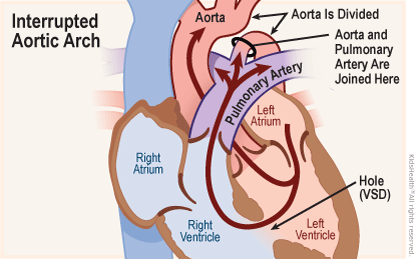Interrupted Aortic Arch (IAA)
What Is an Interrupted Aortic Arch (IAA)?
An interrupted aortic arch (IAA) is a rare heart condition that happens when the aorta doesn’t form completely. The aorta is the heart’s main pipeline, carrying oxygen-rich blood to the body. Normally, it’s shaped like an arch or curve. In an interrupted aortic arch, part of the aorta is missing, leaving a gap.

What Happens When a Baby Has an Interrupted Aortic Arch (IAA)?
In an IAA, the ends of the aorta on either side of the gap are closed, so blood does not flow into the gap. Body parts that are fed by blood vessel branches beyond the gap (such as the legs and belly) will be damaged if the flow of oxygen-rich blood is not restored.

What Are the Signs & Symptoms of an Interrupted Aortic Arch?
The gap in the aorta usually doesn’t cause problems until after a baby is born. That’s because circulation before and during birth lets oxygen-rich blood reach the lower half of the baby’s body through a temporary blood vessel called the ductus arteriosus. Within the first hours or days after a baby is born, the ductus arteriosus normally closes.
When the ductus arteriosus begins closing in a baby with IAA, the baby will look weak and may feed poorly. As the vessel closes more completely, symptoms become more severe and life-threatening. The lack of blood flow and oxygen can damage the liver, kidneys, and intestines.
The baby’s legs may look gray and feel cool compared with the shoulders and head. The baby’s pulse can be felt in the right arm but will be weak or absent in the legs. Depending on the location of the gap in the aorta, a normal pulse might not be felt in the baby’s left arm.
What Causes Interrupted Aortic Arch?
The problem happens when the aorta does not form properly early in pregnancy. Sometimes, it’s related to a genetic condition that can be inherited, but it can happen with no known cause.
An interrupted aortic arch can be related to a genetic disorder such as 22q11.2 deletion syndrome (also known as DiGeorge syndrome), so genetic testing usually is recommended.
Almost all babies born with an IAA also have a hole between the lower chambers of the heart called a ventricular septal defect (VSD). There may be other heart problems, such as an atrial septal defect (ASD) or truncus arteriosus.
How Is an Interrupted Aortic Arch Diagnosed?
Ultrasound images before birth can detect an IAA. Otherwise, changes in a newborn’s appearance and activity 1–2 days after birth can be signs of the problem.
Comparing pulses in the baby’s arms and legs may help identify an IAA. A pulse oximeter can measure the oxygen level in the baby’s fingers and toes. Doctors confirm the diagnosis with an ultrasound of the baby’s heart (an echocardiogram).
How Is an Interrupted Aortic Arch Treated?
Babies whose IAA is found on prenatal ultrasound are treated with a medicine called prostaglandin right after birth. The baby gets the prostaglandin through a tiny intravenous (IV) tube that gives medicine continuously. It slows or stops the closing of the ductus arteriosus so oxygen-rich blood can continue flowing to the baby’s lower body until surgery to repair the aortic arch is done.
If the IAA was not found before birth, prostaglandin is started as soon as the diagnosis is made.
Surgery is done early in the baby’s life, often within the first few days. The surgeon will close the gap in the aorta, rebuilding it into a normal size vessel. The VSD and any other heart problems are usually fixed at the same time.
Treatment also includes:
- heart and other medicines
- intubation (a tube is placed in the baby’s windpipe so a ventilator can give extra oxygen and help the baby’s breathing)
- sedation (medicines to keep the baby asleep while intubated)
What Else Should I Know?
After surgery, oxygen levels throughout the baby’s body will return to normal and most symptoms will disappear. Over time, the child’s aorta and the pathway to the aorta may not grow as fast or as large as they should. The valves or vessels may form a narrow, pinched area called a stenosis, requiring further surgery or a cardiac catheterization procedure to stretch open the narrow area with a balloon.
Follow-up visits with a pediatric cardiologist (a doctor who specializes in treating children’s heart problems) are essential for a baby born with an IAA. The doctor will watch for any problems, such as scar tissue or narrowing in the heart or blood vessels. The doctor might recommend giving the child antibiotics before medical or dental procedures to prevent infections of the heart’s valves and its inner lining.
As kids born with an IAA become teens and young adults, parents should remind them that they need to follow up regularly with their heart doctor.
